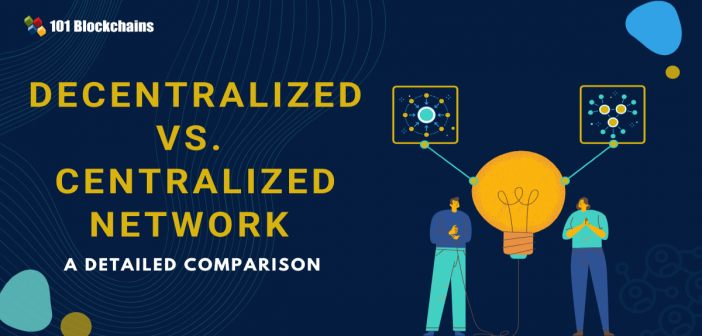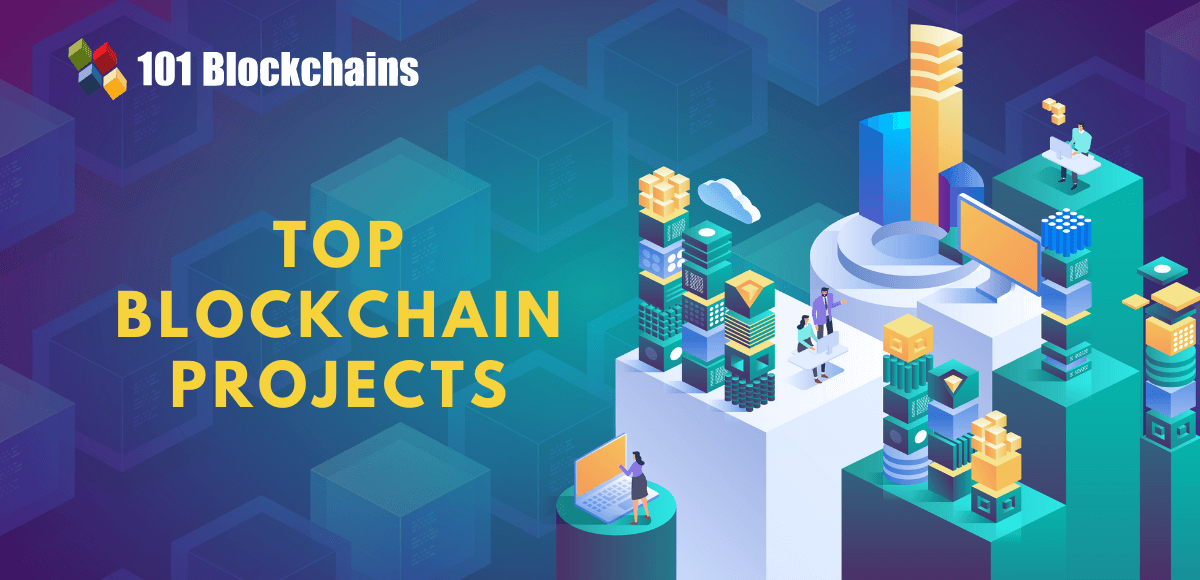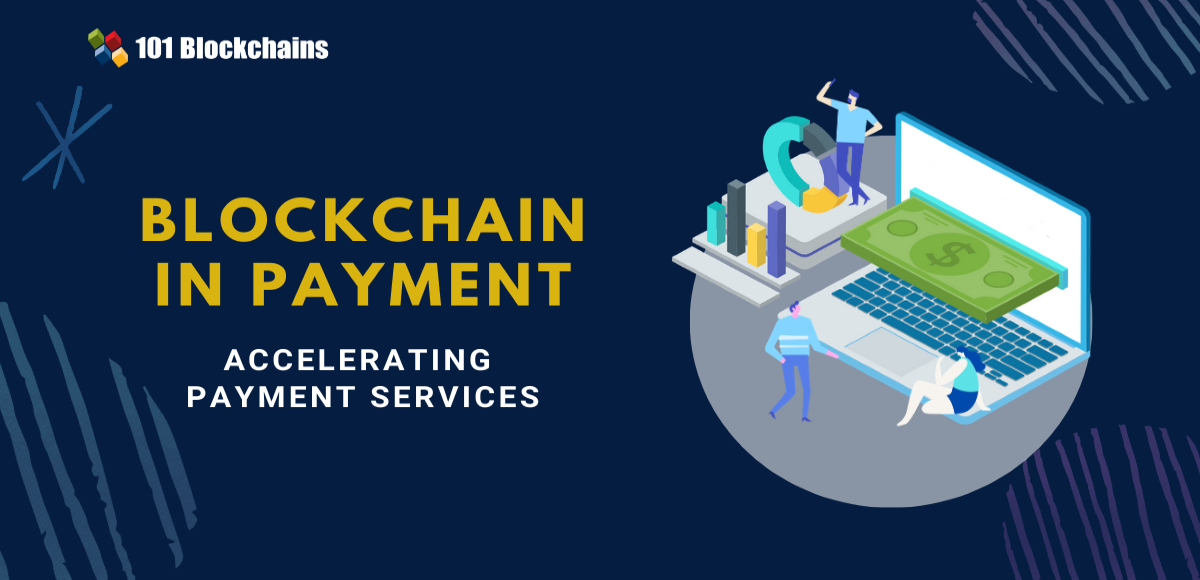In the world of blockchain, you will find the decentralized vs centralized debate a lot. After all, blockchain technology can make centralized systems a thing of the past.
In any scenario, if you are new to blockchain technology, then you might find yourself confused with the centralization vs decentralization concepts.
In this article, we will explore the decentralized vs centralized concept in connection with the current industries and blockchain.
Do you want to become an expert in Blockchain Technology? Enroll Now: Certified Enterprise Blockchain Professional (CEBP)
So, without any delay, let’s get started.
If you are in a hurry, then check out the table.
| Centralized | Decentralized | |
|---|---|---|
| Third-Party Involvement | Yes | No |
| Control | Full control stays with the central authority | Control stays with the user itself |
| Hackable | More prone to hacks and data leaks | Less prone to hacks and data leaks as no single point of failure |
| Single Point of failure | Yes | No |
| Ease of use | Intuitive and easy to use | Not easy to use |
| Exchange fees | Higher fees | Less fees |
| Anonymous | Users are not anonymous | Offers anonymity |
Decentralized vs Centralized: A Complete Comparison
Let’s get started with the comparison of decentralized vs centralized.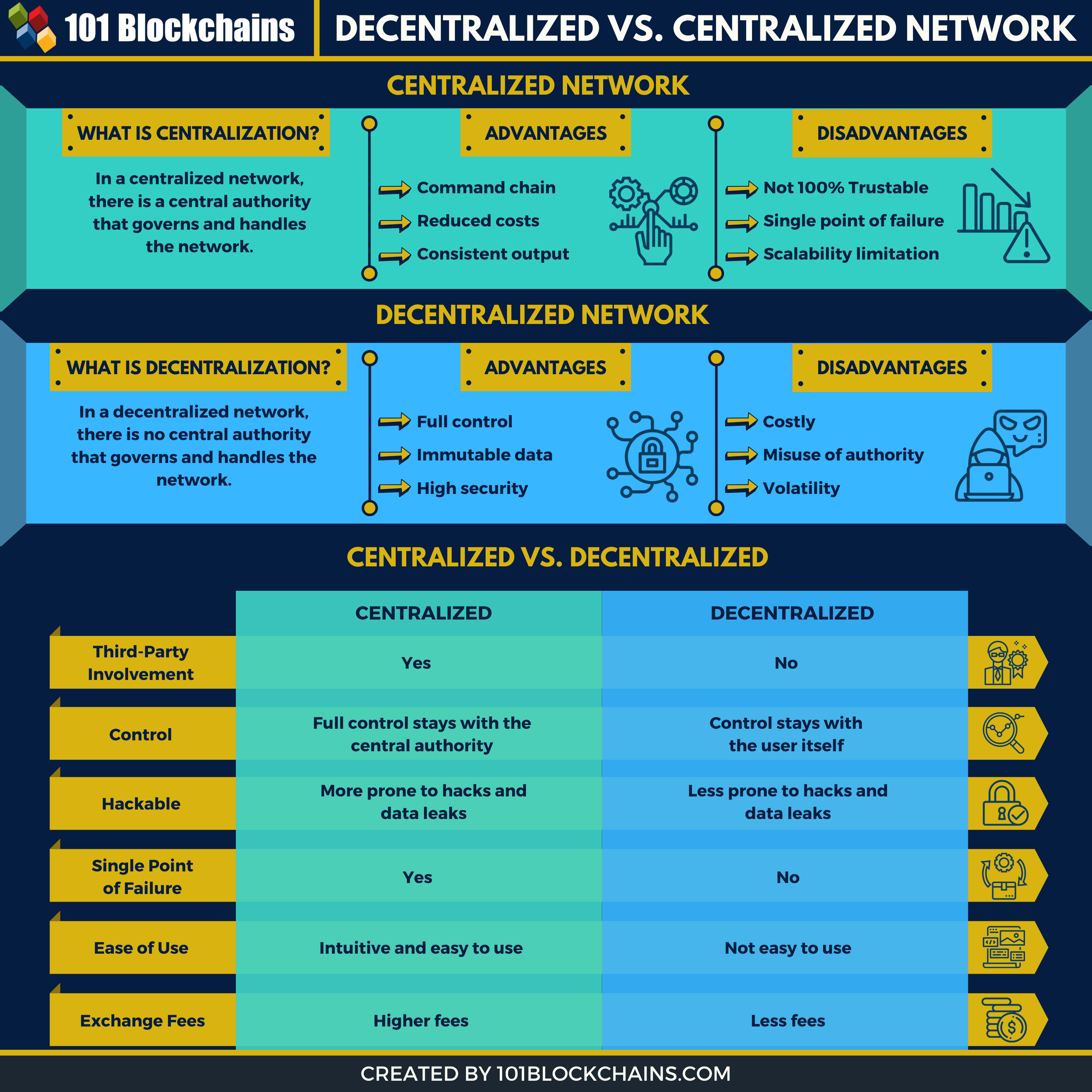
Please include attribution to 101blockchains.com with this graphic. <a href='https://101blockchains.com/blockchain-infographics/'> <img src='https://101blockchains.com/wp-content/uploads/2020/05/Decentralized-vs.-centralized.png' alt='Decentralized vs. centralized='0' /> </a>
Also read,
What is Centralization? And, How Does It Work?
Centralization revolves around us more than you can expect. If you are using social media platforms such as Facebook, then you are using a centralized system. Other popular online platforms such as YouTube are also centralized.
So, what does it mean?
It means that a central authority is in control of the data and functions of the said platform. So, if you are using the Facebook platform, then the company Facebook has complete control over the different aspects of their features including the ability to decide who and who cannot join the platform.
If you want a technical perspective, then the centralized system requires third-party intermediaries to verify data. This means if you are sending a message to your friend using the Facebook platform, then the data will be verified and then transferred by the said platform.
Another great example would be sending an email. The moment you send an email to another person, the email service provider has the knowledge of what you sent and when you sent it. This information is stored privately without any identifier, but the email service, in any case, has a copy of that information.
In short, the centralized services have your information stored with your consent. If you remember the first time you create an account on any centralized platform such as Facebook, Yahoo, Gmail, etc., then you you had to give them your full name, nationality, date of birth, and any other information to register on the platform.
So, why am I telling you all of these?
The fact that everything is stored in a centralized place, it is bound to get hacked or misused for other purposes. Yahoo, in 2015, noticed one of the biggest hacks where the group of hackers was able to view private emails of millions of accounts!
Centralization can also refer to an organization structure where the decision-making capacity is only with few people. This means that we will also cover the decentralized vs centralized organization.
Now that we have got a grasp of a centralized entity, now, let’s take a look at how it works.
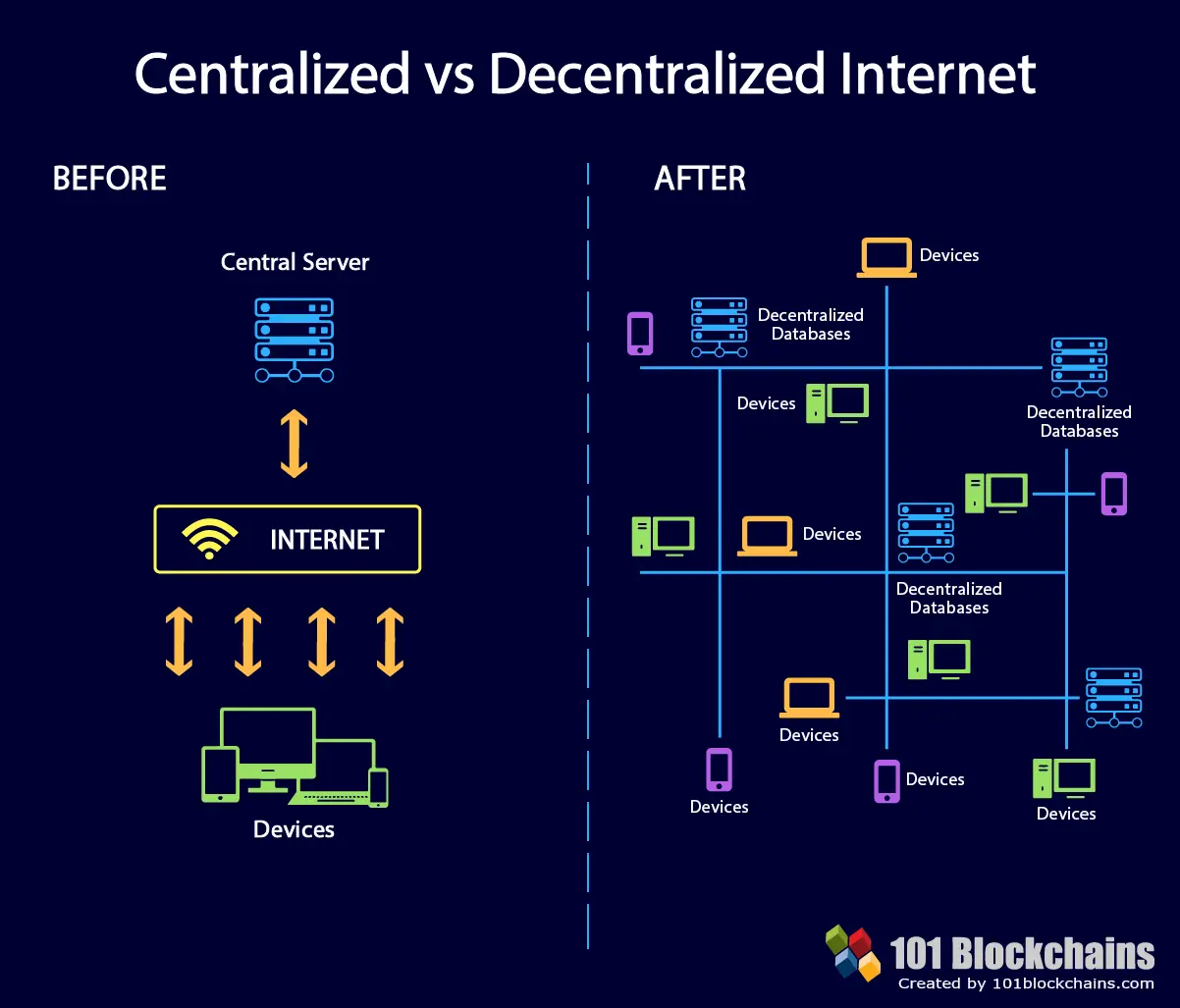
Please include attribution to 101blockchains.com with this graphic. <a href='https://101blockchains.com/blockchain-infographics/'> <img src='https://101blockchains.com/wp-content/uploads/2018/08/From_Centralized_to_Decentralized.png' alt='Centralized vs Decentralized internet='0' /> </a>
Advantages of Centralization
There are undoubtedly multiple benefits or advantages of centralization. They are listed below.
1. Command chain
With centralized, the command chain is clearly defined. If an organization utilizes centralization, they know the chain of command. This means that every person in the organization knows their role and whom they need to report too. They also know which person is under their control and are responsible for their subordinates’ actions as well.
All of these also mean that delegation is easy in the chain. Senior executives can easily delegate work to their subordinates and finalize and finish the work in the best possible way. If work is successfully completed, it creates a level of trust among the workers and chain, improving the confidence required to make it work.
When it comes to a network that utilizes centralization, one central node or a collection of nodes are responsible for transactional verification.
2. Reduced Costs
One of the biggest advantages of centralization is the cost associated with it. Any centralized network or infrastructure requires less support and cost. As centralized organizations or networks are pre-planned, the costs associated with it do not cross budgets until and unless it is absolutely required to expand the network.
3. Quick Decision Implementation
There is no doubt that centralization organizations or networks enable quick decision implementation. As centralized networks have fewer nodes or people, it requires less communication among the different levels of authorization.
Also, if a centralized network decides to implement a change, it can be done in a matter of minutes. For instance, a centralized network can put more stress on the KYC procedure and decided to add more requirements for it. As the network is centralized, they can push the new guidelines or change the KYC procedure which can go live almost instantly after proper testing.
Disadvantages of Centralization
There are also various disadvantages of centralization. Some of them are as below:
1. Trust
Even though centralized organizations are secure and trustable, they are not 100% secure or trustable. The trust is an agreement that is set by the service provider and the user.
However, that’s an agreement and it can break easily. Big corporations suffer from trust issues from their users, from time to time.
It happens when there is a lapse of security in the system, people tend to ignore the service for some time before the service provider mends the trust by offering solutions and remuneration to those affected.
All of this happens because of centralization and the reason that all the data are stored in a centralized database.
2. Single point of failure
Centralization also means that the whole network is dependent on a single point of failure. Organizations know about the disadvantage and hence have deployed measures to contain it. However, the fact that there is a chance for failure is a big disadvantage for mission-critical services.
3. Scalability Limitation
As a single server is used in most cases, it leads to scalability limitations.
What’s the current state of Centralization?
Centralization is undoubtedly an effective way to manage organizations or networks. It has been effectively used by big organizations such as Microsoft, Facebook, Yahoo, and so on. In fact, our governments are also reliant on a centralized approach.
In the case of a centralized government, the political executives coordinate the power. You can also exert the power in multiple cases.
For a big corporation, centralization ensures that its data remains safe. This is needed so that their trade secrets do not get leaked. However, there is a modified way of handling the data with the option to use decentralized networks such as blockchain.
We can easily say that centralization is still very prevalent in the current market. And, not all businesses don’t need to adopt decentralization just for the sake of it. Different business models thrive in a centralized network and it will take a while before more and more business move towards decentralized models.
What is Decentralization? And, How Does It Work?
Now that we have a complete understanding of centralization, it would be easy for us to understand and learn about decentralization.
The idea of decentralization is new. It came to light with the release of bitcoin in 2009. It also introduced one new cool concept that makes decentralization possible, i.e., blockchain technology. Here if one user sends bitcoin to another user, it doesn’t have to go through a centralized authority.
However, this doesn’t mean that the transaction is not verified. The transactions are verified with the use of consensus algorithms.
The network used by bitcoin is connectable by anyone.
That means it is open. It also exhibited other key features such as transparency, where anyone can verify the transactions if needed. In such a network, a person or machine that connects to the network is termed as “node.” In the end, there will be a network with thousands of nodes that are capable of sending and receiving funds from each other.
Let’s take a real-world example to understand the concept.
A decentralized energy network is where people can connect and buy energy from other independent entries. This way, they do not have to pay the intermediaries for accessing energy in the first place.
The distributed energy network relies on blockchain technology with no need for a centralized authority. The nodes that are generating the energy can share it with the network and get paid for it.
Want to know about the working process and infrastructure of bitcoin? Check the presentation for quick overview on What is Bitcoin and How Does it Work
Advantages of Decentralization
There are multiple advantages of decentralization.
1. Full Control
One of the most significant advantages of decentralization is that the users are in full control of their transactions.
This means that they can start a transaction when they want without the need to authorize it from a centralized authority. In simple terms that the verification process is not dependent on third-parties and a decentralized network utilizes consensus methods to verify the information.
2. Data cannot be altered or deleted
Blockchain technology’s data structure is append-only. This means that there is no chance for anyone to modify or alter the data once it is stored. There is another blockchain technology that utilizes different data models such as Corda, but they also follow the immutability property.
3. Secure
Decentralized networks are secure because of how they handle data and transactions. They use cryptography to ensure that the data ledgers are secure. Also, the data in the current block require data from the adjacent block so that it can use cryptography to validate the data.
Want to know about cryptography in cryptocurrency? Check the detailed guide on Use of Cryptography in Cryptocurrency
4. Censorship
Decentralization also means less censorship. In a centralized system, there are more chances that information can be censored. However, the decentralized network is less prone to censorship, as there is no central authority that controls the data. Let’s take an example to understand the scenario.
Twitter, for example, is known to censor accounts as it finds some offensive posts or does it when the government tries to censor accounts if it goes against their agenda.
In the case of decentralization, peers can interact directly, and hence there is no or less censorship.
5. Open development
Decentralized networks mostly support open development. This is because of its nature and how it operates. By having an open development environment, the network gets amazing services, tools, and products built on top of it.
Linux, for example, is open-source and has an ecosystem that enables anyone to improve on it. The same is true for decentralized networks. In comparison, a centralized network or closed solutions do not get the chance to have open development. This limits development to a great extent.
Disadvantages of Decentralization
There are of course many disadvantages of decentralization. Some of the disadvantages include the following:
- Conflict: Decentralization can lead to conflict if it is not well maintained in an organizational structure
- Cost: In an organizational setting, decentralization can cost more than centralization as it requires setting up of systems that can make communication more automatic.
- Crime: When it comes to decentralized blockchain, then the crime can be one big disadvantage. As everything is done on the network is anonymous and can lead to misuse.
- Volatility: Decentralized cryptocurrency shows volatile behavior where the prices fluctuate a lot!
What is the current state of Decentralization?
Decentralization is here to stay. You’ll see that many of the major companies, organizations, and even governments are adopting it as it offers more efficiency to the network in the long run.
Dubai is one of the first waves of governments that are currently adopting blockchain to its whole governance structure. It is now termed as the blockchain development world capital, as decentralization or blockchain technology is influencing it.
At the time of writing, Dubai has been able to integrate blockchain into eight industry sectors, including real estate, tourism, security, transportation, finance, health, and education. The end result is to become the world’s first blockchain city.
IBM is also at the forefront of embracing blockchain technology and using it to improve the food supply chain.
They created IBM Food Trust, which is all about bringing efficiency and transparency to food supply chains. They are working in conjunction with Walmart and benefit all the participants in the network with actionable and traceable information.
There are also various decentralized ledger projects out there including the likes of Hyperledger, Corda, and others.
Want to learn the basic and advanced concepts of Blockchain and Hyperledger Fabric? Enroll Now: Getting Started with Hyperledger Fabric
Use-cases Centralized vs Decentralized
In this article, we will go through some of the use-cases that are related to centralized and decentralized. All these use-cases will help you better understand how each of these concepts differentiates and how decentralization can really help to solve some of the key core problems of centralized systems.
Payments System
One of the most obvious use-cases of decentralization is the payment system. After all, the concept itself arose with the introduction of bitcoin, the first event decentralized currency.
All the currencies in the world that are operated by banks work on top of centralized servers. By doing so, they have full control over all the operations and also know about all your entire financial activities.
Want to know what is the scope and purpose of Decentralized Finance (DeFi)? Enroll Now: Introduction to DeFi – Decentralized Finance Course
This means that they know about your spending habits. However, one of the worst things about using a centralized currency is that if someone gets hold of your bank credentials, they can easily access all your money and use it for their own benefit.
Another disadvantage of centralized payment systems is that there can be a disruption or failure and you will not be able to access your funds when you need it.
So, how does a decentralized system solve all of these? Well, by being decentralized. As there is no central authority or point of failure, your funds are always available.
It also removes the chance of your funds getting hacked or accessed by a malicious actor. So, if you use cryptocurrency as a way to receive and send payments, you take out the role of the centralized entity from the process — improving it in all the way. You can term these cryptocurrencies as peer-to-peer digital currencies.
Another benefit of the payment system is the removal of intermediate fees. The only fees that are associated with the process are either small or non-existent. They are also borderless and secure.
So, what are the pros of using a global payment system? They are as below.
- Quick transactions
- Cheap transactions
- No information is shared among the third party
- Secure
- No single point of failure
- Transparent
Government Voting
Voting has always been a controversial topic among the government and the people who choose the government. The opposing parties are also keen to use the topic to find a way to defend themselves. So, what actually happens.
The whole voting scenario is dealing with one most important issue, transparency. The current way of carrying out the vote doesn’t take transparency into account. This results in a lot of conspiracy theories on how the votes are manipulated internally. As these theories exist, there is no way to validate them as the system is not transparent.
That’s where a decentralized voting platform can come into rescue. Governments can use it to run the votes and provide transparent voting. This way, they can rest all the theories that come out when general election results are declared.
By using a transparent voting system or a voting system running on a decentralized network, the voters can easily verify the votes. This also means that no party can do frauds when it comes to counting of votes. Another benefit of using this approach is that results can be declared as soon as voting is finished.
So, what are the benefits of a decentralized voting system?
- There won’t be any manipulation or fraud
- No conspiracy theories
- No threats
Energy
Another useful use-case that we are going to discuss in our Decentralized vs Centralized comparison concept.
Right now, centralized entities mainly control and distribute the energy who decide where they want to provide their services and at what price.
To solve this, decentralization can come up with a unique solution. It can use a decentralized power grid which you can use to cut the middleman.
It also provides equal opportunity to everyone who wants to get energy or generate energy and then sell it to others.
The pros are of course there including
- Fair market
- No third party involvement
- The decentralized payment system can work with decentralized energy platforms.
Conclusion: Which One Is Here To Stay? Centralized vs Decentralized
Both centralized and decentralized have their own benefits. There is no doubt that governments, organizations, and companies want control over their assets, even when they have to give up efficiency for the sake of it.
But, decentralization is here to stay! And, with time, it will grow as more companies will realize the benefit of it. Also, you can also implement decentralization with a sustainable close environment and with the help of hybrid or federated blockchain solutions.
This leads us to the end of our decentralized vs centralized guide. By now, you should have a good idea of what each of them has to offer.

